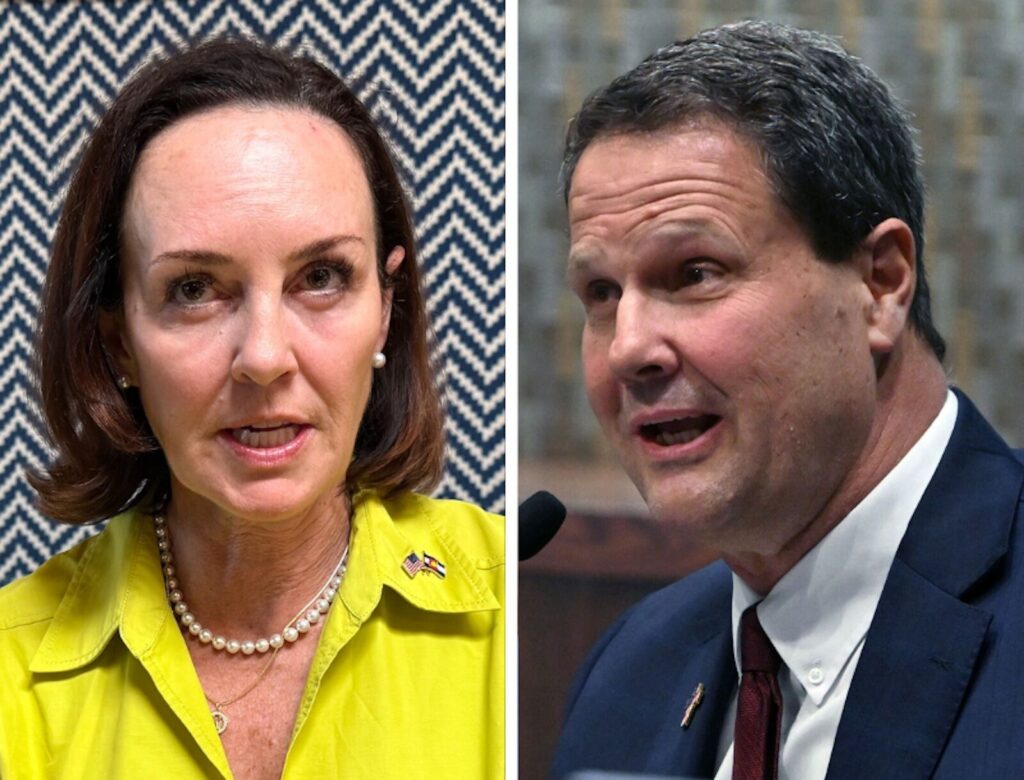Historic turnover on tap as all three Colorado Republicans vacate their US House seats | TRAIL MIX

For the first time in at least 100 years, voters in three of Colorado’s congressional districts can count on sending someone new to Washington after this year’s election.
Over a two-month period, all three of the state’s Republican U.S. House members declared that they will vacate their seats next year, with two announcing that they’ll retire after their current terms and the third proclaiming that she wants to stay in Congress, only from another, less competitive district on the other side of the state.
The guaranteed turnover is nearly unprecedented, as Colorado voters have ushered in as many as three new House members just five times in the state’s almost 148-year history.
U.S. Rep. Buck kicked things off on Nov. 1 in the state delegation’s least surprising farewell, saying he’d decided against seeking a sixth term in the 4th Congressional District, which covers Douglas County and the Eastern Plains.
Buck said he decided to retire over frustration with his fellow Republicans embracing “self-serving lies” while pursuing social media status, instead of tackling the big challenges facing the country.
“It is impossible for the Republican Party to confront our problems and offer a course correction for the future while being obsessively fixated on retribution and vengeance for contrived injustices of the past,” said Buck, a former prosecutor and past chairman of the Colorado GOP.
On Dec. 27, U.S. Rep. Lauren Boebert threw a curveball when the two-term incumbent announced that she is ditching her reelection bid in the competitive 3rd Congressional District to join a crowded primary in the district Buck will vacate.
The nationally prominent incumbent was facing an unexpectedly strong primary challenge from first-time candidate Jeff Hurd and a likely rematch against Adam Frisch, the Democrat who came within 546 votes of unseating her in the last election and had already raised more than three times as much as Boebert, demolishing state records in the process.
Instead of risking defeat in her home district, which encompasses most of the Western Slope and Southern Colorado, Boebert said she plans to move across the state to the safe Republican 4th CD.
“A lot of prayer, a lot of tough conversations, and a lot of perspective have convinced me this is the best way I can continue to fight for Colorado, for the conservative movement, for my kids’ future, and for the future of this great country,” she said.
Her switch wasn’t exactly greeted with open arms – one of the Republicans she’ll be facing in a primary dismissed Boebert as a “another Carpetbagger shopping for a district,” and another called the move “a desperate stunt” and a “vain effort to cling to power” – but Boebert is likely the frontrunner in a large field of candidates vying to take over for Buck.
U.S. Rep. Doug Lamborn dropped bombshell news of his own on Jan. 5, when the long-serving Republican announced his decision to retire after nine terms representing the El Paso County-based 5th Congressional District.
“There are seasons in our lives, and for me, this chapter is coming to a close,” said Lamborn after touting a string of accomplishments across the three decades he’s served as an elected official, including a dozen years in the legislature before he won the congressional seat.
Each of their announcements set off a scurry among fellow Republicans, jumping at the chance to run for a rare open congressional seat in a state where the GOP’s fortunes have been on the decline for decades.
The ranks of aspiring honorables have been growing by the day in recent weeks. At last count there are five Republicans running for the seat Boebert currently represents, four Republicans hoping to replace Lamborn, and an eye-popping 11 declared GOP candidates in Buck’s district, including Boebert.
In contrast, all five Democratic members of Colorado’s House delegation are running for reelection in the districts they represent, with only one – first-term U.S. Rep. Yadira Caraveo in the 8th Congressional District – facing a competitive race. Elected in 2022 to the state’s newest seat by just over 1,600 votes, the Thornton pediatrician’s district, which stretches from suburbs north of Denver to Greeley, is the state’s lone toss-up, nearly evenly divided in voter registration and targeted by both national parties.
Caraveo’s GOP colleagues each represent districts that favor Republicans, though the seat Buck is relinquishing ranks as the state’s lone rock-solid red district.
Once known as one of the largest reservoirs of reliable Republican votes in the country, Lamborn’s district has been trending the other direction in the last decade. Donald Trump won the district by a landslide 22-point margin in 2016 but slipped to a 10-point win in 2020, while Lamborn posted the lowest total vote share of his career in the 2022 election.
Boebert’s 3rd CD switched from a toss-up to “lean Republican” after she announced her move, but Democrats have been making inroads with its voters in recent years, as evidenced by Gov. Jared Polis carrying the district in 2022 and U.S. Sen. Michael Bennet losing there by a whisker.
The Colorado Republicans are part of a trend ahead of the 2024 election, with at least 39 House members – 22 Democrats and 17 Republicans – headed for the exits before the next Congress will be sworn in.
Boebert isn’t included in that tally, compiled by the U.S. House of Representative Press Gallery in its “Casualty List,” since she hopes to return for a third term representing a different seat.
Another six members – three Democrats and three Republicans – have resigned or died in office since the start of the 118th Congress, and one, New York Republican George Santos, was expelled from the 435-member chamber.
All those departures mean that 396 incumbent House members – including Boebert – will seek another term this year.
That number – almost certain to shrink in coming months, with additional retirement announcements anticipated – is about par for the course since World War II, according to an analysis published this week by Kyle Kondik, managing editor of Sabato’s Crystal Ball’s “Notes on the State of Politics,” a project of the University of Virginia Center for Politics.
While most of the retiring members are taking the same route as Buck and Lamborn, putting a cap on their congressional careers, nearly half are giving up their seats to run for higher office, with 12 seeking a promotion to the U.S. Senate, one running for governor, two hoping to be their state’s next attorney general, and one – Minnesota Democrat Dean Phillips – mounting a longshot bid for the White House.
Kondik pegged Lamborn’s retirement as the most impactful of four recently announced Republican departures nationwide, concluding that the district “could potentially be competitive in a general election” if a number of factors break in the Democrats’ direction. Calling the race a “deep sleeper,” Kondik said the possibility that state GOP Chairman Dave Williams could win the Republican nomination prompted his decision to move the seat from “safe Republican” to “likely Republican.”
Regardless of whether Republicans hold all three seats – or whether Boebert’s gambit pays off – voters in Colorado’s 3rd, 4th and 5th CDs will have new representation when the next Congress is scheduled to be sworn in on Jan. 3, 2025.
Over the 26 general elections since the state’s modern political era began in 1972, Colorado has only seen that much churn in its House delegation three times – in 1972, 1986 and 2008 – though each of those shake-ups included at least one incumbent suffering defeat at the ballot box, so it wasn’t until after the election that residents of some districts knew they’d be represented by a fresh face in D.C.
In 1972, Democrat Pat Schroeder ousted one-term Republican Mike McKevitt in Denver’s 1st Congressional District, winning the seat she would hold for 12 terms. Republican Jim Johnson won the 4th CD seat after 12-term Democrat Wayne Aspinall was defeated in his party’s primary, and Republican Bill Armstrong became the first congressman to represent the newly created 5th CD, which has only elected Republicans since.
Fourteen years later, the state’s delegation wound up with three new members, including two who replaced their party’s 1986 U.S. Senate nominees. In the Boulder-based 2nd Congressional District, Democrat David Skaggs succeeded fellow Democrat Tim Wirth, who defeated Republican Ken Kramer to win Colorado’s Senate seat, while Republican Joel Hefley won the 5th CD seat Kramer gave up. On the Western Slope, Democrat Ben Nighthorse Campbell – who would later switch parties after following Wirth to the Senate – unseated one-term Republican Mike Strang in the 3rd CD.
It wasn’t until 2008 that the state would again elect three rookie House lawmakers at the same time. That’s the year Democrat Jared Polis won the 2nd CD seat, following Skaggs’ retirement, and Republican Mike Coffman replaced retiring fellow Republican Tom Tancredo in the 6th Congressional District, which covered the southern metro area. On the crest of the Obama wave, Democrat Betsy Markey beat Republican Marilyn Musgrave in the 4th CD, though Markey would only hold the seat for a single term.
Prior to those elections, the state refreshed its delegation almost entirely in 1912, electing three new members the same year Colorado’s House contingent grew from three to four. In 1932, in the throes of the Great Depression, three Democrats defeated three Republicans, as the party swept to power on Franklin Delano Roosevelt’s coattails.
The decisions by Buck, Boebert and Lamborn to give up their seats this cycle clears the way for new representation in their three districts, adding 2024 to a short list of Colorado elections with a record number of openings for newcomers to the delegation.
Ernest Luning has covered politics for Colorado Politics and its predecessor publication, The Colorado Statesman, since 2009. He’s analyzed the exploits, foibles and history of state campaigns and politicians since 2018 in the weekly Trail Mix column.














